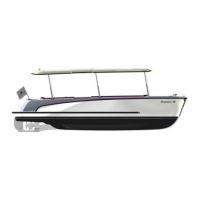
Do you have a question about the Alfastreet Marine Energy 18 and is the answer not in the manual?
| Brand | Alfastreet Marine |
|---|---|
| Model | Energy 18 |
| Category | Boat |
| Language | English |
Advises paying attention to weather forecasts, sudden changes, storms, fog, and thunderstorms for safety.
Provides essential safety rules for awareness, speed, visibility, traffic, and avoiding fatigue during navigation.
Ensures passengers know and apply basic safety measures, emphasizing awareness of dangers and following rules.
Addresses common accident causes like lack of knowledge and negligence; stresses conscious, careful, and responsible operation.
Presents the legally required equipment for inshore/sheltered coastal areas, including anchor, ropes, safety gear, and signals.
Specifies that life jackets must match the number and size of persons on board and have an adequate certificate.
Emphasizes the importance of life jackets for survival, instructing on their use, fitting, and checking for suitability and damage.
Details procedures for water rescue, including returning to the person, calling them, and pulling them aboard safely.
Provides procedures for fire prevention and extinguishing, including abandoning the vessel if fire is unmanageable.
Outlines actions to take in case of sinking or capsizing, such as switching off equipment and activating help signals.
Details procedures for collision and flooding, including reducing speed, using the water pump, and reporting accidents.
Describes actions to take when running aground, including checking for leaks, assessing damage, and seeking towing assistance.
Instructs on what to do in case of motor or steering breakdown, including switching off, anchoring, and calling for help.
Lists essential emergency contact numbers for sea emergencies, distress calls, and police.
Warns against alcohol and drug use, emphasizing focus, sobriety, and rest for safe vessel operation.
Describes the GEL batteries used, their advantages, maintenance, safety valve, self-discharge, and disconnection procedure.
Emphasizes switching off the motor and using correct fuses to prevent fires and ensure safety during absence.
Explains how to control the motor's speed and direction using the remote throttle and magnetic key for safety.
Provides a troubleshooting guide for common motor issues, including error codes and flowchart for diagnosis.
Stresses the importance of checking fuel levels or battery charge before departure to ensure a safe return.
Emphasizes checking the weather forecast before departure to anticipate storms, wind, and wave conditions.
Lists essential pre-departure checks: passenger awareness of life jackets, rescue equipment readiness, and conductor's emergency knowledge.
Details the safety mechanism that shuts down the motor if the conductor leaves the console, preventing uncontrolled movement.
Stresses constant awareness of surroundings, immediate motor shutdown in emergencies, and passenger safety.
Reinforces that passengers must stay seated and wear life jackets for their safety and the conductor's focus.
Crucially advises switching off all electrical equipment and main switches to prevent fires and electrical faults.